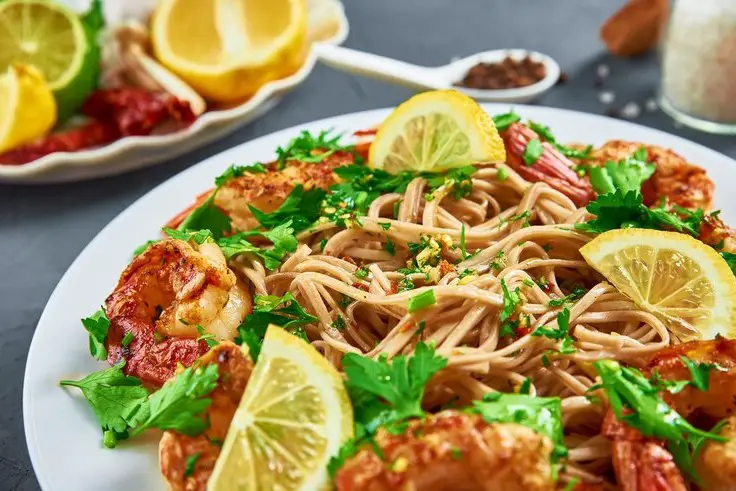Key Ingredients and Flavors
The heart of Greek Spaghetti lies in its harmonious blend of select ingredients, each contributing to its distinctive flavor profile. Essential to this dish is olive oil, a cornerstone of Greek cooking, lending a rich, fruity base. Feta cheese, with its creamy and tangy notes, adds depth and a touch of Greek authenticity. The inclusion of ground beef or lamb introduces a hearty element, often enhanced with a sprinkle of cinnamon for a subtle, warm spice. These ingredients, along with garlic, onions, and sometimes fresh herbs, create a simple yet flavorful dish that is quintessentially Greek.
This dish’s nutritional profile aligns well with the Health Benefits of Mediterranean Cuisine, emphasizing healthy fats, lean proteins, and aromatic herbs.
Variations Across Regions
Greek Spaghetti exhibits delightful variations as it traverses the diverse regions of Greece. In the mainland, a heartier version often features ground beef or lamb, while the islands might favor seafood, reflecting their coastal bounty. The intensity of spices like cinnamon can vary, with some areas preferring a more pronounced flavor. In the north, a richer, butter-based sauce is common, whereas the southern regions lean towards lighter, olive oil-based preparations. These regional differences not only add to the dish’s culinary diversity but also tell a story of Greece’s varied geography and the local palates.
Each variation not only offers a different taste but also tells a story of the local culture and traditions. To understand more about these regional differences and their historical roots, visit History of Greek Cuisine.
Preparing the Perfect Greek Spaghetti
Traditional Greek Spaghetti Recipe
Embarking on the journey of preparing traditional Greek Spaghetti is a delightful experience. Here’s a step-by-step guide to creating this classic dish:
Ingredients:
- 400g spaghetti
- 2 tablespoons olive oil
- 1 large onion, finely chopped
- 2 cloves garlic, minced
- 500g ground beef or lamb
- 1 teaspoon cinnamon (optional)
- 400g canned tomatoes, crushed
- Salt and pepper, to taste
- 200g feta cheese, crumbled
- Fresh parsley, chopped (for garnish)
Instructions:
- Cook the Spaghetti: Begin by cooking the spaghetti according to the package instructions until al dente. Drain and set aside.
- Sauté Onions and Garlic: In a large skillet, heat the olive oil over medium heat. Add the chopped onions and garlic, sautéing until they are soft and translucent.
- Brown the Meat: Increase the heat to medium-high and add the ground beef or lamb to the skillet. Cook until the meat is thoroughly browned, breaking it up with a spoon as it cooks. If you’re using cinnamon, sprinkle it over the meat for a uniquely Greek flavor.
- Add Tomatoes: Stir in the crushed tomatoes, and season with salt and pepper. Reduce the heat to low and let the sauce simmer for about 15 minutes, allowing the flavors to meld together.
- Combine with Spaghetti: Add the cooked spaghetti to the sauce, tossing gently to ensure the pasta is evenly coated.
- Serve with Feta and Parsley: Transfer the spaghetti to a serving dish. Sprinkle crumbled feta cheese and fresh parsley over the top for a burst of flavor and a touch of color.
- Enjoy: Serve hot, allowing the warmth of the dish to release the full spectrum of flavors.
This traditional Greek Spaghetti recipe offers a taste of Greece’s rich culinary heritage, with each ingredient playing a crucial role in creating a harmonious and satisfying meal.
Modern Twists on the Classic
While traditional Greek Spaghetti is a timeless dish, contemporary chefs and home cooks alike have embraced creative variations, infusing new life into this classic recipe. These modern twists not only cater to diverse palates but also reflect the dynamic nature of Greek cuisine.
Fusion Recipes
- Greek-Italian Fusion: Marrying the flavors of Greece and Italy, this version incorporates sun-dried tomatoes and black olives, adding a tangy and briny dimension. Topped with a mix of feta and Parmesan cheese, it bridges two culinary worlds in one dish.
- Spaghetti with Greek Yogurt Sauce: For a creamy twist, some chefs replace traditional tomato sauce with a Greek yogurt-based sauce. This variation is lighter yet creamy, with a tangy yogurt sauce seasoned with garlic, dill, and lemon zest.
- Seafood Greek Spaghetti: Inspired by Greece’s coastal regions, this version features shrimp or scallops sautéed in olive oil with garlic and tossed with spaghetti. It’s a nod to Greece’s rich seafood traditions, offering a lighter but equally flavorful alternative.
Contemporary Variations
- Vegetarian Greek Spaghetti: Catering to vegetarian diets, this variation omits meat and instead focuses on a bounty of vegetables like spinach, bell peppers, and cherry tomatoes, all sautéed in olive oil and mixed with feta.
- Whole Wheat Greek Spaghetti: Health-conscious cooks often opt for whole wheat spaghetti, adding a nutty flavor and more fiber to the dish. This variation pairs well with leaner meats like turkey or even plant-based meat substitutes.
- Spicy Greek Spaghetti: For those who enjoy a bit of heat, adding chili flakes or sliced fresh chili to the tomato sauce introduces a spicy kick, contrasting beautifully with the coolness of the feta cheese.
These modern interpretations of Greek Spaghetti demonstrate the versatility and adaptability of the dish. By experimenting with different ingredients and flavors, one can enjoy a fresh take on this beloved Greek classic, making it suitable for various tastes and dietary preferences. For those interested in exploring more pasta dishes with a twist, check out Green Spaghetti Recipe, a flavorful twist on a classic dish.
Cooking Tips and Techniques for Greek Spaghetti
Perfecting Greek Spaghetti involves more than just following a recipe; it’s about mastering certain techniques and understanding the nuances of the ingredients. Here are some expert tips to elevate your Greek Spaghetti:
- Quality of Olive Oil: The foundation of this dish is olive oil. Use extra-virgin olive oil for its superior flavor and aroma. It not only enhances the taste but also brings authenticity to the dish.
- Browning the Meat: To develop deep flavors, properly brown the meat. This means cooking it until it gets a nice, caramelized crust. Avoid overcrowding the pan, as this can lead to steaming rather than browning.
- Balancing Spices: If using cinnamon, be cautious with the quantity. A little goes a long way, and it should complement, not overpower, the other flavors.
- Cooking Pasta Al Dente: Cook the spaghetti until it is al dente – tender but still firm to the bite. This texture is crucial as it prevents the pasta from becoming mushy when mixed with the sauce.
- Feta Cheese: Crumble the feta cheese by hand for a rustic and authentic feel. Its tangy flavor balances the richness of the meat and the sweetness of the tomatoes.
- Simmering the Sauce: Allow the sauce to simmer gently. This slow cooking process melds the flavors together and results in a richer, more cohesive sauce.
- Fresh Ingredients: Whenever possible, use fresh tomatoes, garlic, and herbs. Fresh ingredients offer a brightness and depth of flavor that canned or dried versions can’t match.
By adhering to these tips and techniques, you can ensure that your Greek Spaghetti is not just a dish, but a culinary masterpiece that captures the essence of Greek cooking. For more detailed cooking techniques and tips, check out Cooking Techniques and Tips.
Pairing with Other Dishes
To create a truly memorable Greek dining experience, pairing Greek Spaghetti with complementary dishes is key. These pairings should enhance the flavors of the spaghetti while offering a variety of textures and tastes. Here are some suggestions:
- Greek Salad: Start with a classic Greek salad, featuring crisp cucumbers, juicy tomatoes, red onions, Kalamata olives, and feta cheese. Dressed in a simple olive oil and lemon vinaigrette, it offers a refreshing contrast to the hearty spaghetti.
- Grilled Vegetables: Serve a side of grilled vegetables like zucchini, bell peppers, and eggplants. Their smoky flavor and tender texture complement the richness of the spaghetti.
- Tzatziki Sauce: A bowl of cool, creamy tzatziki made with Greek yogurt, cucumber, garlic, and dill can be a delightful dip for warm pita bread, balancing the spices in the spaghetti.
- Stuffed Grape Leaves (Dolmades): These little parcels of rice and herbs wrapped in grape leaves are a great appetizer, offering a burst of lemony, herby flavors.
- Greek Lemon Potatoes: Roasted potatoes with a lemon-oregano dressing can be a comforting addition, harmonizing well with the spaghetti’s flavors.
- Baklava for Dessert: End the meal with baklava, a sweet, nutty pastry that provides a delightful endnote to the savory spaghetti.
These complementary dishes not only round out the meal but also bring a variety of Greek flavors and textures to the table, making the dining experience more enjoyable and authentic.
Nutritional Information of Greek Spaghetti
Greek Spaghetti, while indulgent, also offers several nutritional benefits. The dish is a good source of protein, primarily from the ground beef or lamb, essential for muscle growth and repair. The olive oil used is rich in monounsaturated fats, known for their heart-healthy properties. Additionally, feta cheese provides calcium for bone health. However, it’s important to consider the dish’s calorie and fat content, especially if using larger amounts of cheese and oil. For a healthier version, opt for lean meats and moderate the cheese and oil. Whole wheat spaghetti can also be used to increase fiber intake.
Storing and Reheating Greek Spaghetti
Proper storage and reheating are crucial for maintaining the quality of leftover Greek Spaghetti. To store, let the spaghetti cool to room temperature, then place it in an airtight container. It can be refrigerated for up to 3-4 days. For freezing, use freezer-safe containers or bags, and it can last up to 2 months. When reheating, gently warm it in a saucepan over medium heat, adding a splash of water or broth to loosen the sauce. This method helps retain the moisture and flavor. Avoid microwaving at high power, as it can make the pasta mushy.
FAQs
Q: Can I make Greek Spaghetti vegetarian? A: Absolutely! Replace the meat with mushrooms or chickpeas.
Q: What’s the best type of pasta for Greek Spaghetti? A: Traditional spaghetti works best, but feel free to experiment with other types.
Q: How can I make this dish gluten-free? A: Use gluten-free spaghetti and ensure all other ingredients are gluten-free.


